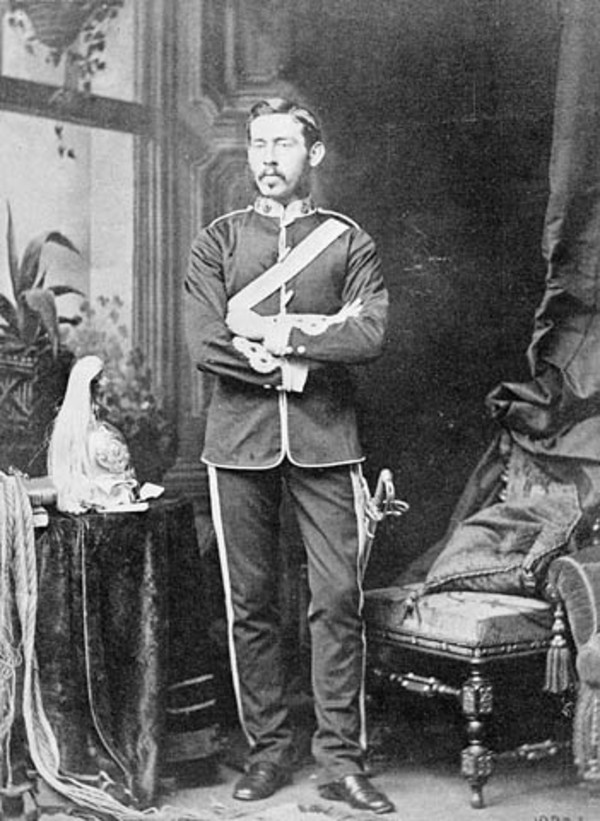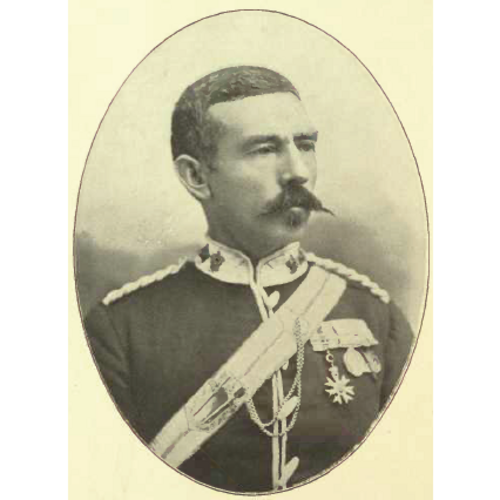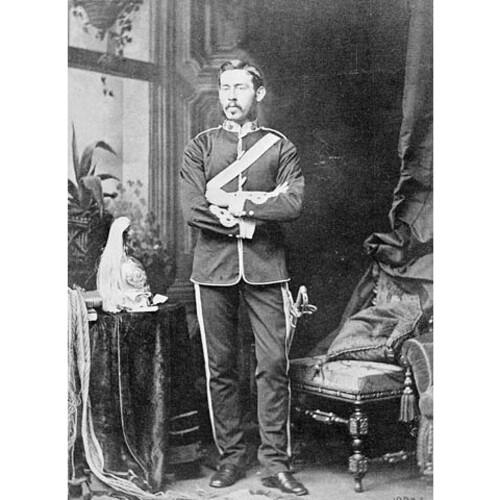DENISON, FREDERICK CHARLES, militia officer, lawyer, author, politician, and businessman; b. 22 Nov. 1846 at Rusholme, near Toronto, fourth child of George Taylor Denison* and Mary Anne Dewson; m. 22 April 1874 Julia Abigail Macklem, and they had six sons and two daughters; d. 15 April 1896 at Rusholme.
A member of an influential and wealthy family with a keen interest in the militia, Frederick Charles Denison was privately educated until 1858, when he entered Upper Canada College. In 1864 he became a law student at Osgoode Hall. Called to the bar in 1870, he entered practice with his elder brother, George Taylor*. As George became increasingly occupied as a militia officer, author, and police magistrate, the work of the thriving practice fell more and more on Fred.
Even while he was a student, Fred Denison had begun his own long association with the Canadian militia. In 1864 he gained a 2nd class certificate (qualifying him to command an infantry company) from the School of Military Instruction run by the British army in Toronto; the next year he was on active service for four months as a lieutenant in the 2nd (Central) Administrative Battalion, which patrolled the Niagara frontier at the end of the American Civil War. On 25 Aug. 1865 he was gazetted cornet in the 1st Volunteer Militia Troop of Cavalry of York County; in April 1866 it became the Governor General’s Body Guard under George’s command. With his troop, Fred was again in the field during the Fenian crisis of 1866, commanding a picquet following the action at Ridgeway (Fort Erie) [see Alfred Booker*] and later a cavalry outpost at Thorold. There he probably first met Colonel Garnet Joseph Wolseley*, a promising British officer who was commanding a training camp for the militia.
At the time of the disturbances at Red River in 1869–70 [see Louis Riel*], a combined British-Canadian expedition was organized to go overland to maintain order. Determined to participate, Denison obtained a position as Canadian “orderly officer” to the commander, Wolseley, apparently through the connivance of George and Wolseley. Like the other young officers in the expedition, he throve on the hard work involved in building a road from Prince Arthur’s Landing (Thunder Bay) to Shebandowan Lake, then sailing and portaging cumbersome boats and supplies through the wilderness. He learned the art of running boats through white water. “It was great fun,” the young athlete reported after his first attempt. In the final advance on Upper Fort Garry (Winnipeg), on 24 Aug. 1870, he assumed an aide-de-camp’s more traditional role as a mounted scout, astride a farmer’s horse, and was the first to discover that the fort was empty. After Wolseley’s British troops returned east in the autumn, Denison remained in Manitoba for nearly a year as aide-de-camp to Lieutenant Governor Adams George Archibald. During this time he found a lifelong friend in Dr John Christian Schultz, a leading member of the Canadian party in Red River. With such an associate, it is scarcely surprising that young Fred became critical of the French-speaking Métis.
In 1872, after a dispute between George Denison and Sir George-Étienne Cartier*, minister of militia and defence, had brought about George’s resignation, Fred assumed command of the Body Guard and was promoted captain. Four years later a reorganization, under a Liberal government, brought George back to command the squadron and Fred, promoted to the brevet rank of major, took charge of “A” troop. In the same year his only publication, the Historical record of the Governor-General’s Body Guard, which he had been working on for over two years, was printed. But social prominence as a cavalry officer at a time when the militia was languishing was not enough for someone who dreamed of active service. In 1878 he made overtures for a place in any Canadian contingent should war break out with Russia and the following year for one with Wolseley in Natal. His efforts unrewarded, he tried for at least a rise in rank to brevet lieutenant-colonel, but his petitions to Major-General Richard George Amherst Luard, the general officer commanding the Canadian militia, and Sir John A. Macdonald were to no avail. He subsequently applied without success to Luard for a commission in the Canadian regular force Cavalry School Corps organized in 1883.
Nevertheless Denison’s position in the prestigious Body Guard could only be an aid to his career as a Toronto politician. As early as December 1875 he had campaigned for his uncle Richard Lippincott Denison as alderman in the newly formed St Stephen’s Ward. When Richard died in March 1878, Fred decided to run in the ensuing by-election. His support was such that at the nomination meeting the other two candidates withdrew and he was acclaimed. Soon elected to city council’s executive committee, he worked to get College Street extended westward to his family’s land holdings. He was again acclaimed at the end of 1878, and was elected in 1880 and 1881. In January 1881, although one of the youngest members of council, he was elected chairman of the executive committee.
At the end of 1881 he did not seek re-election and took his wife on an extended European tour. In England, Wolseley ensured that he was presented at court and was given opportunities to see the British army and volunteers training.
Although Denison had not anticipated re-entering politics, in June 1883 he was acclaimed as an alderman for St Stephen’s Ward following a resignation. He was soon chairman of both the executive and the finance committees, and on occasion acted for Mayor Arthur Radcliffe Boswell. An active proponent of Toronto’s annexation of Rosedale, Riverside, and Brockton, he was again acting in the family interest, for the Denisons held land in Brockton. In 1884 Denison’s name was being mentioned as a possible candidate for mayor the following year. Any thoughts of a bid for the mayoralty were overtaken by Denison’s plunge into imperial events.
In the spring of 1884 Major-General Charles George Gordon, in the Sudan training a native army to counter a fundamentalist Moslem insurrection led by the Mahdī was besieged in Khartoum by the Mahdists and after lengthy procrastination the British government determined to send an expedition to his rescue. Lord Wolseley, its commander, concluded that the problem of moving troops to the vital point was similar to that experienced on the Red River expedition, and that the soldiers must ascend the Nile in specially constructed whale-boats. Out of the blue, while Denison was holidaying in August at Chippawa, Ont., a telegram came from the governor general’s military secretary, Lord Melgund [Elliot*], offering him command of a civilian force of Canadian boatmen. This 37-year-old lawyer, civic politician, colonial amateur soldier, and family man was being asked to rejoin the Wolseley ring of officers, which had been growing in expertise and reputation in colonial wars. He did not hesitate for a second in accepting this rare offer of active service.
Denison was soon immersed in the responsibilities of selecting and equipping the boatmen (rivermen, lumbermen, and Indians, all supposedly with experience on treacherous waterways), although much of the work was done by Melgund. He unsuccessfully resisted the inclusion of a Winnipeg contingent led by Lieutenant-Colonel William Nassau Kennedy*, claiming they were not voyageurs, but really because Kennedy would outrank him. Denison got his brevet rank of lieutenant-colonel and Kennedy’s men joined the expedition. It left Quebec City on 15 September. Reaching Egypt in October and ascending the Nile to where the relief expedition was struggling upriver, the men were stationed in groups on bad stretches of water to assist the soldiers manning the whale-boats. Denison’s responsibilities were limited to personnel administration and the direction of those of his men within his immediate reach by canoe. He was assisted by his youngest brother, Egerton Edmund Augustus, who had made his way privately to Egypt after being refused by Melgund and had been given a post with the expedition.
The voyageurs were not soldiers. It required fines and a sharp lecture from Denison to make them realize that they would have to work on Sundays. Among the army there was gossip about their indiscipline. Denison blamed Kennedy’s Manitoba gang. He himself set an example to voyageurs and soldiers alike in embarking stores and tracking whale-boats. In spite of the voyageurs’ labours, the army progressed slowly. When in December Denison learned of Wolseley’s plan to dispatch camel-mounted cavalry directly across the desert to succour Gordon, he asked to go “in any capacity – or as a spectator – as the senior Canadian present.” He was ordered to continue with the less glamorous but vital column of infantry and supplies, commanded by Major-General William Earle, on the longer river route. He became its chief pilot, searching out the best channels.
It had become obvious by this time that the campaign would stretch beyond the voyageurs’ six-month engagement and that their continued participation would be essential. In spite of an offer of increased pay and sightseeing stopovers in Cairo and London on their return, Denison could persuade only 89 of his 380 men to re-engage. Many were committed to river work in Canada and others were afraid of the punishing heat of an African summer. But Denison himself wrote home on 25 Jan. 1885, “I would not miss this part of the campaign for anything. We are now in the enemy’s country.”
Unknown to the expedition, Khartoum fell on 26 January and Gordon was killed. The Mahdists, who had been retreating before the river column, suddenly stiffened their resistance. Denison, as usual at the point of the column’s advance, came under fire for the first time in his militia career. On 10 February in a British attack at Kirbekan he was well forward with the infantry and revelled in the excitement. The Mahdists suffered heavy losses; General Earle was killed. But the Mahdists were concentrating, the desert column lacked supplies and water, and Wolseley ordered a speedy withdrawal. For the next nine days the army was totally dependent on the voyageurs and their leader as the boats ran the rapids. By 6 March they were out of danger. By the 13th Denison had reached Cairo, where he was hospitalized with enteric fever. While he lay helpless for six weeks, Kennedy led the voyageurs back to England.
When Denison arrived in London at the end of May, he found himself a minor hero. He met the Duke of Cambridge, went to the Derby, and attended a state dinner. In a month he was back in Toronto, his arrival somewhat overshadowed by the excitement of the North-West campaign [see Sir Frederick Dobson Middleton], in which the Body Guard finally saw active service, without him. Nevertheless, he was a celebrity and in August came the award of the cmg. He was “the first Denison in Canada to receive an honour,” he noted in his diary. Soon he was sought as an after-dinner speaker to give his impressions of the Sudan campaign. Proposed as mayor in 1885 and again in 1886, he withdrew on both occasions in favour of Alexander Henderson Manning*.
But his law practice, the Body Guard, and his expanding holdings of stores and rural properties were no longer enough for Denison. In the federal election of 22 Feb. 1887 he ran as a Conservative in Toronto West, winning a narrow victory over Edmund Ernest Sheppard*. Denison did not speak often in the House of Commons, but he did take a prominent part in militia debates. Like the other “Parliamentary Colonels,” he was quick to use his position to attack Canada’s infant permanent force [see Sir Adolphe-Philippe Caron*], which took scarce funds from volunteer corps such as the Body Guard. And like most mps of the era, he took an intimate interest in the minor patronage posts that he could influence.
In 1889 Denison, following the lead of D’Alton McCarthy, broke ranks with the Conservatives to vote to disallow the Jesuits’ Estates Act of Quebec. The following year he was again putting strains upon his party by seconding McCarthy’s private member’s bill for an amendment of the language clauses of the North-West Territories Act to limit the use of French; their bill was defeated. “Right or wrong at all times, the Colonel had the courage of his opinions,” the Toronto World would later report. It is scarcely surprising that, although his name had been mentioned in the commons in 1889 as a possible minister of militia and defence (Caron held the post), he was not invited to join the cabinet. However, the same year he was able to use his political influence to have the Body Guard increased to a regiment of four troops. As a squadron commander in the enlarged unit, he had his substantive rank raised to major (although he was already a brevet lieutenant-colonel).
In the Conservative election victory early in 1891, Denison was returned in Toronto West with the largest majority in Ontario, the second largest in the whole country. However, the Conservatives were losing their impetus. With the death of Macdonald that June the choices to replace him were unimpressive. In his diary Denison candidly reviewed the possibilities: John Joseph Caldwell Abbott (“not known outside his province”), McCarthy (“distasteful to the French”), Sir John Sparrow David Thompson (“being a catholic & active in Jesuit bill most objectionable to Ontario conservatives”), and Sir Charles Tupper* (“with reputation of feathering his own nest & unscrupulous . . . will probably come to the top in the end”). In the new government headed by Abbott, Denison was again the pick of some for minister of militia and defence, but again he was passed over.
Throughout his last years Denison was the object of an unpleasant controversy. He claimed that James Gibson Slater, a British army veteran who had enlisted with the Body Guard for 1885–88, was a drunkard and ordered him to return his kit at the end of his term. He did not, and Denison had him brought before magistrate’s court and fined. In turn, Slater brought a civil suit against Denison, claiming $250 for drill instruction and caring for his troop’s arms and accoutrements. This suit failing, Slater had his case printed as a pamphlet in 1891 and distributed to all mps He also charged that officers of the Body Guard had pocketed money which should have gone to the men. When the Liberal opposition brought up these charges in the commons, Denison was put to some pains to refute them. Unable to get satisfaction in parliament, Slater threatened to shoot Denison, and then took his case to the governor general, the Colonial Office, and the British parliament. In 1893 William Mulock* aired the whole question again in the house. Denison called him a “Cowardly blackguard . . . for two pins – I would break his head.”
In October 1895 appeared the first symptoms of the stomach cancer which was to cause Denison’s death six months later at Rusholme, then within the city’s limits. His funeral, although private, was like a state procession. The eight pallbearers represented the military and Conservative élites of Toronto. In Ottawa, Tupper announced his death to the commons and Wilfrid Laurier* gave the eulogy.
Denison’s career was something of a dichotomy. On the one hand he remained all his life very much a man of Toronto. He was a conventional municipal politician. Even as a federal legislator, he ensured that much of his effort was on behalf of Toronto. On the other hand, although his military career was always under threat of being overshadowed by that of his brother George, in 1884–85 he succeeded in breaking through the limits of a Canadian militia career by means of his friendships among the gifted Wolseley ring of officers. He thus commanded Canadians in their first military venture overseas as part of an imperial force.
Frederick Charles Denison is the author of Historical record of the Governor-General’s Body Guard, and its standing orders (Toronto, 1876). His portrait, held at MTRL, Hist. Picture Coll., is reproduced as the frontispiece of Records of the Nile voyageurs, 1884–1885: the Canadian voyageur contingent in the Gordon relief expedition, ed. C. P. Stacey (Toronto, 1959).
MTRL, Denison family papers, L22–23. NA, MG 29, E29, 15, 36. G. T. Denison, Soldiering in Canada; recollections and experiences (Toronto, 1900). [J. G. Slater], Three years under the Canadian flag as a cavalry soldier; a peep behind the scenes of political, municipal, military, and social life in Canada ([Ottawa, 1892]). Chadwick, Ontarian families. CPC, 1889. Cyclopædia of Canadian biog. (Rose and Charlesworth), 1: 246–47. Roll of U.C. College (A. H. Young), 207. D. P. Gagan, The Denison family of Toronto, 1792–1925 (Toronto, 1973).
Cite This Article
O. A. Cooke, “DENISON, FREDERICK CHARLES,” in Dictionary of Canadian Biography, vol. 12, University of Toronto/Université Laval, 2003–, accessed December 31, 2025, https://www.biographi.ca/en/bio/denison_frederick_charles_12E.html.
The citation above shows the format for footnotes and endnotes according to the Chicago manual of style (16th edition). Information to be used in other citation formats:
| Permalink: | https://www.biographi.ca/en/bio/denison_frederick_charles_12E.html |
| Author of Article: | O. A. Cooke |
| Title of Article: | DENISON, FREDERICK CHARLES |
| Publication Name: | Dictionary of Canadian Biography, vol. 12 |
| Publisher: | University of Toronto/Université Laval |
| Year of publication: | 1990 |
| Year of revision: | 1990 |
| Access Date: | December 31, 2025 |






